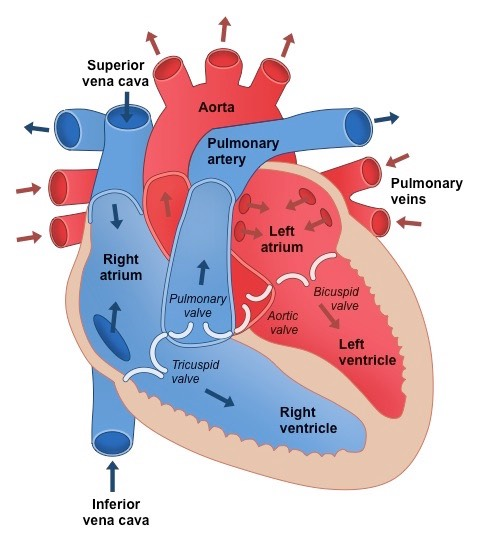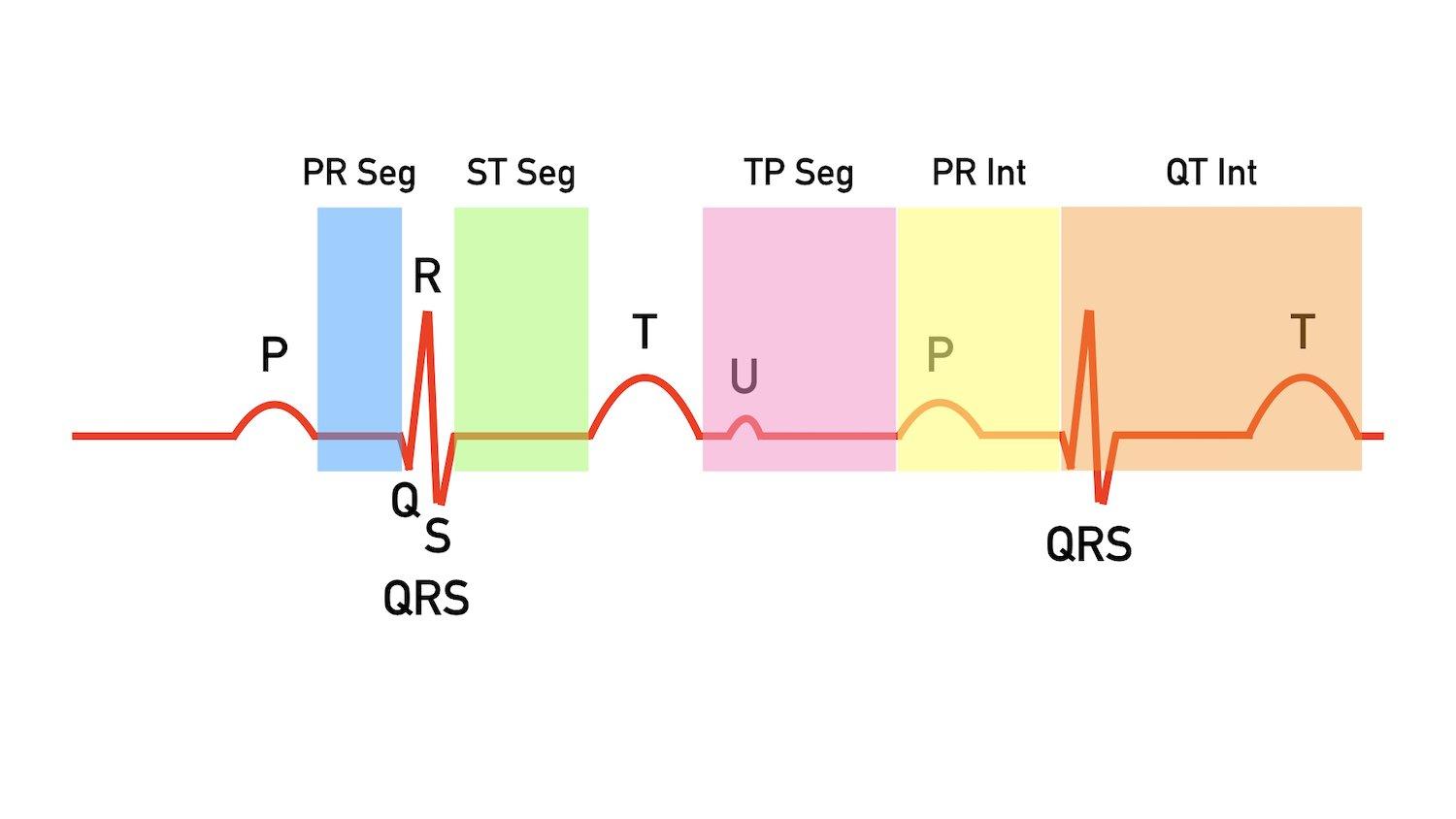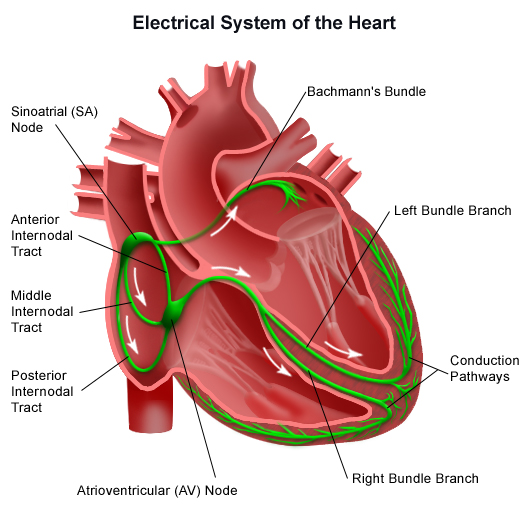
Heart
The Heart
The main organ responsible for the efficiency of the blood’s circulatory system
Incredible strength and endurance
Hollow, cone-shaped
Weighs less than 1 pound, about the size of a closed fist
Located in the mediastinum, the medial cavity of the thorax, the apex of the heart lies on the diaphragm and points left of the body

Blood Flow Through the Heart
Deoxygenated blood enters through the Superior & Inferior Vena Cava
Into the Right Atrium
Through Tricuspid Valve
Into Right Ventricle
Through Pulmonary Semilunar Valve
Out of the Right & Left Pulmonary Arteries
Into the Right & Left Lungs
Oxygenated blood returns through the Right & Left Pulmonary Veins
Into the Left Atrium
Through Mitral Valve
Into the Left Ventricle
Through the Aortic Semilunar Valve
Through the Aorta
Delivered to the rest of the body
Cardiovascular
Consists of two main components; the heart (cardio) and the blood vessels (vascular).
The heart produces contracting force in order to distribute the blood throughout the body and connects the pulmonary and systemic circulatory systems.
Blood vessels make up the vessel network in the body, and function to carry blood from the heart to organs, delivering various substances and removing metabolic wastes from the body.
The cardiovascular system is only part of the circulatory system.
Circulatory
Circulatory system mainly includes the heart, blood vessels, blood, lymph and lymph vessels.
It is a closed system that consists of the heart, and two circulatory branches, named the pulmonary circulation and the systemic circulation.
The pulmonary system carries blood to the alveoli (air sacs) of the lungs so that gasses may be exchanged
The systemic system provides blood supply to all body tissues; delivering oxygen, nutrients, and other needed substances while carrying away carbon dioxide and other metabolic waste
Major Blood Circuits
Blood leaves the heart through arteries and returns by veins
The two main circulations of the body:
General or systemic circulation carries blood throughout the body
Pulmonary circulation carries blood to the alveoli (air sacs) of the lungs so that gasses may be exchanged
The heart is double pump that serves both.
Stethoscope
Used during health assessments to listen to sounds of the heart, lungs, abdomen, and cardiovascular system.
The bell is pressed lightly against the body part to listen to low-pitch sounds, such as abnormal cardiovascular sounds.
The diaphragm is pressed firmly against the body part to listen to high-pitched sounds, such as normal heat sounds, breath sounds, and bowel sounds
Ear tips should face towards the bridge of the nose.
The apex is where the heartbeat is most easily felt and heard through the stethoscope
Press your fingers between the fifth and sixth ribs (midclavicular line, just below center of breast), you can easily feel the apical impulse caused by the the apex of your heart contacting the chest wall
Place the diaphragm of a stethoscope over the hearts apex
This is the area between the fifth and sixth ribs, along an imaginary line extending from the middle of the left clavicle
The heartbeat is heard and felt easily at the apex, now you know where the heart is located (not the left side of the body)
Electrocardiogram

Types of rhythms
Major categories
Sinus
Originate
Atrial
Originates
Regularity
Is it regular?
Look at R-R interval
Regularly
Basically
Totally irregular
Rate
What is the exact rate?
Over a 6 second period count the R’s and multiply by 10
Count small squares between R waves and divide by
You can also count big boxes and divide by 300
Scale:
1 large P wave
Cardiac Conduction

Stroke Volume
Preload Contractility Afterload
fast filling time sympathetic stimulation increased vascular resistance
decreased filling time parasympathetic stimulation decreased vascular resistance
Heart
The Heart
The main organ responsible for the efficiency of the blood’s circulatory system
Incredible strength and endurance
Hollow, cone-shaped
Weighs less than 1 pound, about the size of a closed fist
Located in the mediastinum, the medial cavity of the thorax, the apex of the heart lies on the diaphragm and points left of the body

Blood Flow Through the Heart
Deoxygenated blood enters through the Superior & Inferior Vena Cava
Into the Right Atrium
Through Tricuspid Valve
Into Right Ventricle
Through Pulmonary Semilunar Valve
Out of the Right & Left Pulmonary Arteries
Into the Right & Left Lungs
Oxygenated blood returns through the Right & Left Pulmonary Veins
Into the Left Atrium
Through Mitral Valve
Into the Left Ventricle
Through the Aortic Semilunar Valve
Through the Aorta
Delivered to the rest of the body
Cardiovascular
Consists of two main components; the heart (cardio) and the blood vessels (vascular).
The heart produces contracting force in order to distribute the blood throughout the body and connects the pulmonary and systemic circulatory systems.
Blood vessels make up the vessel network in the body, and function to carry blood from the heart to organs, delivering various substances and removing metabolic wastes from the body.
The cardiovascular system is only part of the circulatory system.
Circulatory
Circulatory system mainly includes the heart, blood vessels, blood, lymph and lymph vessels.
It is a closed system that consists of the heart, and two circulatory branches, named the pulmonary circulation and the systemic circulation.
The pulmonary system carries blood to the alveoli (air sacs) of the lungs so that gasses may be exchanged
The systemic system provides blood supply to all body tissues; delivering oxygen, nutrients, and other needed substances while carrying away carbon dioxide and other metabolic waste
Major Blood Circuits
Blood leaves the heart through arteries and returns by veins
The two main circulations of the body:
General or systemic circulation carries blood throughout the body
Pulmonary circulation carries blood to the alveoli (air sacs) of the lungs so that gasses may be exchanged
The heart is double pump that serves both.
Stethoscope
Used during health assessments to listen to sounds of the heart, lungs, abdomen, and cardiovascular system.
The bell is pressed lightly against the body part to listen to low-pitch sounds, such as abnormal cardiovascular sounds.
The diaphragm is pressed firmly against the body part to listen to high-pitched sounds, such as normal heat sounds, breath sounds, and bowel sounds
Ear tips should face towards the bridge of the nose.
The apex is where the heartbeat is most easily felt and heard through the stethoscope
Press your fingers between the fifth and sixth ribs (midclavicular line, just below center of breast), you can easily feel the apical impulse caused by the the apex of your heart contacting the chest wall
Place the diaphragm of a stethoscope over the hearts apex
This is the area between the fifth and sixth ribs, along an imaginary line extending from the middle of the left clavicle
The heartbeat is heard and felt easily at the apex, now you know where the heart is located (not the left side of the body)
Electrocardiogram

Types of rhythms
Major categories
Sinus
Originate
Atrial
Originates
Regularity
Is it regular?
Look at R-R interval
Regularly
Basically
Totally irregular
Rate
What is the exact rate?
Over a 6 second period count the R’s and multiply by 10
Count small squares between R waves and divide by
You can also count big boxes and divide by 300
Scale:
1 large P wave
Cardiac Conduction

Stroke Volume
Preload Contractility Afterload
fast filling time sympathetic stimulation increased vascular resistance
decreased filling time parasympathetic stimulation decreased vascular resistance
 Knowt
Knowt
